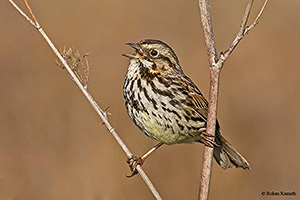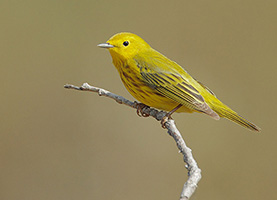Dominance Hierarchies |
|
|---|---|

 photograph of a Song Sparrow (top) by Rohan Kamath photograph of a Yellow Warbler (bottom) by Tom Grey |
It
all started with hens. Norwegian scientist Thorleif
Schjelderup-Ebbe wondered how peace was kept in their
flocks, and conducted a series of experiments to find out.
He discovered that things were tranquil only in established
flocks -- ones in which each hen knew its place. And the
hens learned their places in fights over chicken feed. Once
a hen had been bested in a squabble, it henceforth would
defer to the victor. Each hen knew whom it could dominate,
and by whom it would be dominated. A "peck order" was thus
established in the flock and functioned to maintain social
stability. Hens can recognize many other hens and can
remember their dominance status relative to each. One hen
demonstrated the ability to recognize 27 other individuals
belonging to four different flocks. As you would expect, the
birds at the top of the peck order benefited both by
increased access to food and by avoidance of injuries (even
bullies can get hurt in fights). The birds at the bottom,
while having to wait until those higher up had eaten their
fill, at least were not subjected to continuous fights that
they were likely to lose. In all but polyandrous species of birds (those where one female mates with more than one male), males are normally dominant over females. That is especially true in the early stages of pair formation, although in some buntings and other finches and in some gulls, a reversal of dominance, with the male becoming subordinate, reportedly occurs after the pair bond is established. In experiments, females have been able to assume higher ranks |
|
in dominance hierarchies after receiving
injections of male hormones and by dyeing their feathers to
resemble male plumage. Results of such experiments varied
from species to species; doses of male hormone increased the
social status of female European Chaffinches and Japanese
Quail, but not of starlings. It is usually assumed that a high position in a dominance hierarchy increases the chances of survival and also increases reproductive output. In species where males display on leks, the dominant male generally holds the best territory on the lek and successfully copulates with the most females. But there is relatively little evidence in monogamous species that dominant individuals have a better chance of survival than subordinates. A study of juvenile Song Sparrows on an island near Victoria, British Columbia, showed that dominance relationships at millet-provisioned feeders during summer were reflected in chances for surviving the subsequent winter and establishing a territory the following spring. In two consecutive years, dominant males showed 35 and 22 percent better survival than subordinate males. For dominant females the equivalent figures were 32 and 33 percent. The effects on successful settlement of territories were similar for both sexes -- dominant individuals were more likely to settle into territories than subordinates. The same study showed that sex and age were the major determinants of dominance. Males more frequently dominated females than vice versa; males tended to win about 60 percent of their encounters with females at the feeders, females about 40 percent. Time since hatching had a strong effect on the success of encounters, even when only 24 days separated the oldest juvenile from the youngest. In contrast, no effect of body size on dominance was detected; a small bird was as likely to dominate a larger one as the reverse. Overall, it appeared that next after sex and age, previous experience in encounters was the most important factor in achieving dominance. Thus, early nesting would appear to be the best reproductive strategy for Song Sparrows. Young produced early in the season will gain the most experience and are the most likely to survive to reproduce. But if nesting is started too early, offspring may be killed by food shortage or late winter storms. Undoubtedly, there is a fine ecological line between reaping the advantages of early nesting and suffering the consequences of premature breeding. In another study of Yellow Warblers, however, Michael Studd and Raleigh Robertson of Queens University in Ontario discovered that the nestlings of subordinate birds grew just as fast as those of dominant birds. At least by that measure (to be sure, not an exhaustive one), natural selection was not operating in favor of dominant birds. It has been suggested that in many circumstances being dominant is no more advantageous than being subordinate. For example, a dominant male may obtain a territory which is more resource-rich than that of a subordinate, but it may have to spend much more energy to protect it. Therefore, costs and benefits may more or less balance one another at each level in a dominance hierarchy, and evolution may favor the maintenance of the hierarchy itself, rather than just those near the top (which could lead to the disappearance of differences in dominance). Such a situation in which selection leads to the coexistence of several different modes of behavior has been called by British evolutionist John Maynard Smith a "mixed evolutionarily stable strategy." |
|
| SEE:
Bird Badges;
Natural Selection;
Visual Displays. Copyright ® 1988 by Paul R. Ehrlich, David S. Dobkin, and Darryl Wheye. |
|